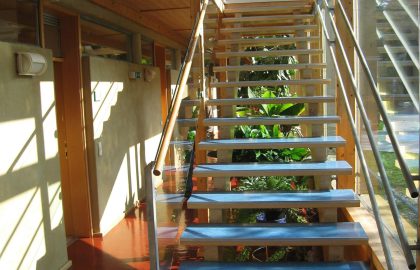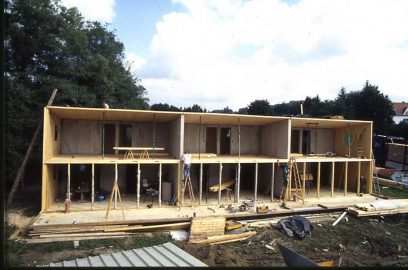The office building is situated within the entire complex in such a way that it is the first thing that visitors from the village notice. While the same construction principle as in the residential buildings is employed in the office building, the system is reversed. In the living spaces, direct sunlight is desirable, but in the office, diffuse light is preferred. As a result, the conservatory in the office building serves as an access and recreation area, and the office spaces are lit primarily from the north and indirectly from the south (via the conservatory). Access is also from the south through an airlock. The office spaces are designed for uniform temperatures and lighting conditions, whereas the recreation and access area is subject to varying temperatures and lighting to provide a higher quality experience and stimulation. Thus, the entire building has two distinct climate zones: the relatively small office spaces with computer workstations are optimally conditioned for work, while the large southern area is subject to outdoor weather conditions and serves as a contrasting space. This creates two areas that complement each other in every way (working spaces and communication/relaxation spaces). A workshop and heating plant room (cellar replacement) are attached to the north of the building, as well as a buffer storage tank. Between the solar collector zone in the south and the office spaces is a solid wall, plastered with clay, designed to passively capture solar energy and release it slowly in the evenings and mornings. Conversely, this massive wall also absorbs nighttime coolness and contributes to overheating protection.
Residential Units
These buildings are based on the same basic system (solid storage wall and entirely wooden construction) but with the opposite arrangement of different areas: access is from the north, and the living spaces are all directly sunlit from the south. The conservatories are located in front of the living spaces.The urban planning concept attempts to incorporate the western green area (near the stream) by shifting the buildings. The buildings facing the street are shielded by parking lots and ancillary spaces (such as stroller and drying rooms). Sunlight studies helped find a construction layout that avoids mutual shading.The technical equipment, building materials, and prefabricated system are identical to the office building, but the functional concept is reversed to suit the partially contrasting usage requirements. The living spaces receive direct sunlight, and the conservatories serve as extensions of the living spaces.The complex also served as a pilot project for the development of the prefabricated house concept “Sundays.”
Energy Concept
Geothermal Energy: Earth-air heat exchangers, in the form of pipes (diameter = 200 mm, length: 25 m), are used. Three units in the office building pass the incoming air through the ground, pre-warming or pre-cooling it. In the coldest period of the year, the maximum temperature difference is 15K: with outside temperatures of -10°C, the incoming air is heated to +5°C. Over the winter, the earth cools down along the entire bore length and warms up accordingly in the summer, resulting in a certain seasonal effect. Passive Solar Utilization: This is achieved both directly through sunlight entering the living spaces via the south-facing glazing and indirectly through the conservatories. The conservatory glazing allows for nearly complete solar harvesting of the winter sun. Conservatory air is drawn through the earth-air heat exchanger, pre-warmed, and further heated as needed in the conservatory before being pulled into the living spaces. In the case of the residential buildings (with lower conservatory insulation and no permanent occupancy), air is only drawn from the conservatory on sunny winter days (fresh air from below and exhaust at the highest point). On winter days without sun, fresh air is directly introduced into the living spaces. Active Solar Utilization: Above the conservatories are exhaust flaps for overheating protection during summer. These flaps are covered with solar panels along the entire length of the conservatories. Approximately one-third of the total 233 m² of solar panels (large-area elements, absorber: titanium nitride oxide coating) are located on each building, forming a combined system. The system covers around 70% of the hot water demand and 50% of the heating demand. Solar operation follows the low-flow principle, in combination with a buffer storage tank (14 m³) with integrated stratified loading. Photovoltaic Solar Utilization: The grid-connected photovoltaic system (approximately 17 m²) has a capacity of 1.44 kWp. The primary purpose of the system is to ensure that, despite a high degree of building technology installations, there is a decrease in electricity consumption from the grid, rather than an increase. Additionally, electricity consumption is reduced by using the solar system to heat the water in household appliances (washing machine and dishwasher).Low-Temperature Heating System: This heating system, which is favorable for utilizing solar energy, is integrated into the walls (and, in some areas, the floors). Natural gypsum fiberboards with integrated plastic pipes act as partition walls between the rooms. The average flow temperature during the heating season is below 30°C. (The hot water storage tanks are charged using the same network with higher temperature during a nightly “time window”).Biomass for the Remaining Energy Demand: The remaining heating demand is supplied by a pellet boiler. Energy Surpluses: The original plan to use summer heat surplus from the thermal collectors to heat the nearby swimming pool was implemented several years after completion. This measure makes the project energy-productive in its overall balance: the project represents an environmental benefit overall during its operation.Water Management: Rainwater is collected in a cistern for the office building and used for toilet flushing and garden irrigation.Results: As part of the planning process, the Working Group for Renewable Energy (AEE) conducted a simulation (TRANSYS) that calculated a heating energy demand (accounting for passive gains and excluding active gains) of 20 kWh per heated net usable area per year (kWh/m²a) for the office building and 33 kWh/m²a for the row houses.The measurement results for the office building (over two years) and for one of the residential houses (for one year) showed significant deviations from these values. The thermal solar system covers around 70% of the total heat demand and about 60% even during the heating season.The remaining energy consumption (i.e., the additional heating demand that the building itself, including active solar utilization, does not cover) supplied by the pellet boiler, is only 8 kWh per m² of heated net usable area per year (kWh/m²a) for the office building after the solar contributions and only 13 kWh/m²a for the row house on the outskirts (in comparison, passive houses are calculated to consume up to 15 kWh/m²).The electricity yield of the PV system per installed kWp was 1210.3 kWh, aligning well with the simulation estimate (1200 kWh).Technical Highlights: Solid wood construction (with concrete inner walls), wooden thermal insulation, and wooden finishing components. Controlled ventilation, earth-air heat exchangers, conservatories integrated into the ventilation system, solar hot water collectors with a central storage tank, rainwater collection system, biomass heating (pellets).


































